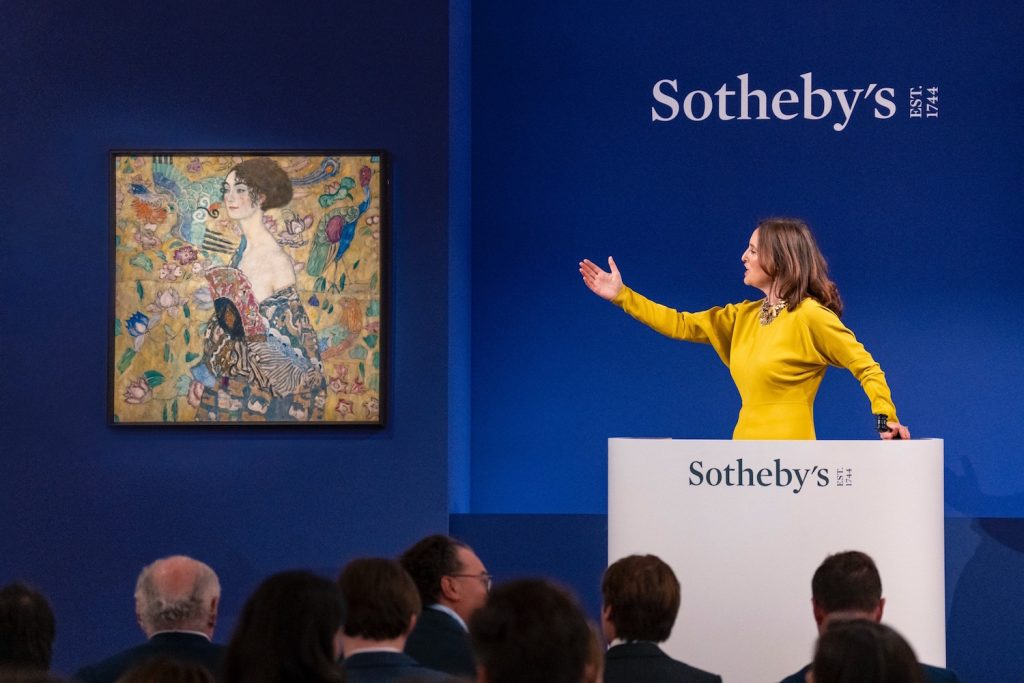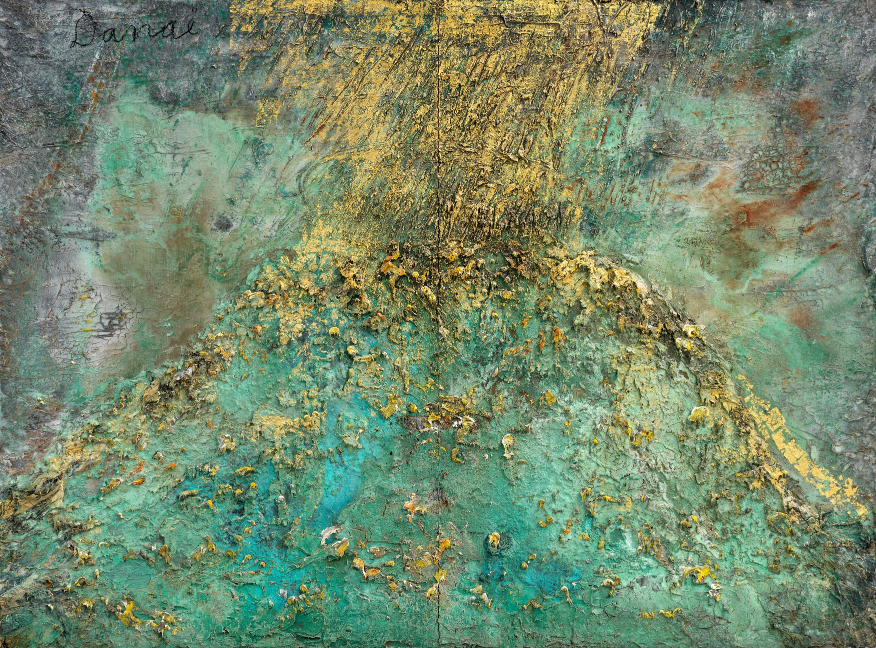Reflecting on a decade of change, Brian Boucher explores the trend for Asian collectors acquiring works by Modern and contemporary western artists

Auctioneer Helena Newman with Gustav Klimt’s Dame mit Fächer (Lady with a Fan), 1918.
Photo: Sotheby’s
Each time auctioneer Ian McGinlay thought he had the final bid for an untitled 1947 painting by Joan Miró at Sotheby’s 50th Anniversary Modern Evening Auction in Hong Kong in April this year, he was mistaken. A tense silence filled the room as a 20-minute contest developed. Sotheby’s experts, including Alex Branczik, chairman of modern & contemporary art, Asia, and Jen Hua, deputy chairman, Asia, were taking bids by phone. Finally the bidding reached HK$41.5 million (HK$50.6 million/$5.3 million with fees) against an HK$32 million low estimate. This was a new record for Miró in the region; when the hammer came down, the room broke out in applause.
Asian collectors are becoming more prominent on the global art scene than ever before. Branczik says that Sotheby’s client base is rapidly expanding in the region, with record numbers of bidders and three times more collectors aged under 40 bidding in 2022 than in 2021. He also says that buyers from Asia spent on average 20% more than buyers from other regions and bid 40% higher.

Picasso, Portrait of Dora Maar, 1939.
Photo: © Succession Picasso/Dacs, London 2023
They have also broadened in their collecting interests from focusing principally on the art and antiquities of their own regions to pursuing masterworks by western artists such as Pablo Picasso, Gerhard Richter and Louise Bourgeois. As referenced in Sotheby’s Insight Report The Art Market Beyond $1 Million, 2018–2022, Asian collectors now account for almost 20% of all bidders for modern and contemporary art with estimates over $1 million.
There have, of course, always been Asian collectors buying at the highest level. In the late 1980s, Japanese buyers famously acquired several major works by Monet and Van Gogh, including a then-record-breaking $82.5 million for Van Gogh’s Portrait of Dr Gachet, 1890, during a stock market boom. But the extent of the change has been recent, rapid and dramatic, says Branczik, who transferred to Hong Kong from London in 2021.
Collectors used to be few and far between. “When I started at Sotheby’s back in 2004, the entirety of our business there basically funnelled through one person, our then-chairman of Sotheby’s Asia [who was based in London],” says Branczik. “All of our Asia offices had this one London phone number. Today, Sotheby’s presence constitutes a huge matrix of connections and networks of specialists. It is a completely different picture.”

Artwork of Anna Weyant, source: Anna Weyant, Gagosian
Asian collectors come from many countries, including South Korea, Japan, Taiwan and Indonesia. But the region’s recent ascent is undoubtedly connected to the development of Mainland China and Hong Kong as leading art market centres, driven by their fast-growing numbers of billionaires and millionaires.
Initially it was Chinese contemporary artists who benefited from the economic and cultural rise of Mainland China. In the early 2000s, western collectors went wild for work by artists such as Zhang Xiaogang, Yue Minjun and Liu Ye. Branczik was the first to bring Chinese contemporary art to a major Sotheby’s contemporary art sale in London in 2006. “The vision was to sell Chinese art to westerners but also, by including these artists in London auctions, to attract Chinese collectors to western artists,” he says.
That vision has paid off, as leading auction houses, art fairs and galleries report many deep-pocketed collectors joining their European and American counterparts in their passion for western modern and contemporary art. In April 2022, a Picasso portrait of Dora Maar, 1939, sold to a Japanese collector for HK$169.4 million ($21.6 million) at Sotheby’s Hong Kong. In the same sale, Louise Bourgeois’ Spider IV (conceived in 1996, cast in 1997) fetched HK$129.2 million ($16.5 million), becoming the most expensive sculpture ever sold in Asia.
In October last year, contemporary artists also did well, driven by millennial bidders. Gerhard Richter’s Abstraktes Bild, 1990, sold for just over HK$200.4 million ($25.5 million) the second-highest price for the artist at auction in Asia. Younger artists such as Cecily Brown, Louise Bonnet, Loie Hollowell and Anna Weyant have also sold exceptionally well in Hong Kong.

Abstraktes Bild, 1990 by Gerhard Richter,
sold for 200,443,000 HKD at Sotheby’s Hong Kong, October 7, 2022,
Contemporary Evening Auction.
This year, as Sotheby’s celebrates the 50th anniversary of its first auction in Hong Kong, it announced plans for new spaces in the city, Seoul and Shanghai, and an enhanced calendar of special auctions. When it commemorated its 40th anniversary a decade ago, no western artists appeared in the corresponding sales. This time, several works by modern western artists featured, including paintings by Picasso, Miró and Marc Chagall. Picasso’s Femme dans un fauteuil, 1948, sold for HK$93.1 million ($11.9 million), while Chagall’s Fiancée avec bouquet, 1977, made HK$27.1 million ($3.5 million). In the contemporary sale, Loie Hollowell’s Standing in Red, 2019, sold for HK$17.9 million ($2.3 million), more than three times its low estimate.
Two months later, attention shifted to London, where the highlight of the Modern and Contemporary Evening Auction was Gustav Klimt’s last great portrait, Dame mit Fächer (Lady with a Fan), 1918, painted shortly before the artist’s untimely death in the global influenza pandemic that year. Four bidders battled for 10 minutes to secure the painting, which eventually sold for £85.3 million ($108.4 million) – a record for the artist and for a work sold in Europe. It subsequently emerged that the successful bidder was a Hong-Kong-based collector.

Dame mit Fächer (Lady with a Fan) by Gustav Klimt,
the successful bidder was a Hong-Kong-based collector
Many collectors are building on their deep holdings of historic, modern and contemporary Asian art, specialists say. “Over the past few decades, Asian collectors have built sizeable collections,” says Felix Kwok, head of modern art, Asia. “They are more than happy to extend their collections to a wider spectrum now.” The overall wealth of the Asia-Pacific region has grown four-fold since 2000, while the region now accounts for 26% of the world’s billionaires – almost as many as Europe, according to research firm Wealth X – meaning they can collect at the highest level.
Collectors have also opened a wave of private museums to show their acquisitions, which in turn is driving taste among younger visitors and collectors. The Long Museum, which has branches in Shanghai and Chongqing, was founded in 2012 by Wang Wei and Liu Yiqian. As well as exhibiting many Asian artists, it has recently devoted shows to contemporary American artists including Joel Mesler and Hollowell.
The late Chinese-Indonesian collector Budi Tek’s Yuz Museum in Shanghai showcases renowned Chinese artists alongside western giants such as Anselm Kiefer and Alberto Giacometti. The jewel in Hong Kong’s crown, the M+ museum, which opened in 2021 after 14 years in development, also mixes Chinese and Asian art with work made by artists from around the world.

Anselm Kierfer, Danaë, 2014, source: Gagosian
Whether homegrown or imported from the west, art fairs have been a crucial element in the matrix, says Jen Hua. That changed in 2013 with the founding of Art021 Shanghai and the inaugural Art Basel Hong Kong (previously the regional fair, Art HK), followed by the West Bund Art & Design fair in Shanghai in 2014. Hua was speaking at Art Basel in Basel, where she was accompanying a group of collectors from countries including the Philippines, Japan and Vietnam who, she says, “want to follow in China’s footsteps”.
New fairs are popping up throughout the region, too. Frieze Seoul will hold its second edition this autumn (6–9 September) and Tokyo Gendai, in Yokohama, Japan, held its inaugural fair in July. They join two other newcomers to the scene, Art SG in Singapore (second edition, 19–21 January 2024), and Taipei Dangdai in Taiwan, which started in 2019 (next edition, May 2024).
Jeffrey Rosen – co-founder of Tokyo’s Misako & Rosen gallery, whose roster includes an international mix of artists – saw the positive effects of this growth at its first two art fairs in Asia, Frieze Seoul in 2022 and Art Basel Hong Kong this year. “Any number of collectors who visited in Hong Kong were surprisingly familiar with our programme,” he said. “That was a clear indication that there had been a shift.” And even though the buyers in Seoul were mainly foreign, he noted a “genuine interest” among Korean visitors in learning about unfamiliar artists.
“I feel very excited when I see the art market is active not only in Hong Kong but also in Singapore, Seoul, Taipei, Tokyo, Shanghai and Beijing,” says Kwok. “It’s like in Europe, which has Milan, Geneva, Düsseldorf and Berlin, in addition to London and Paris. When I see new fairs in Singapore, I’m really happy. Meanwhile, Tokyo is finally being more open to the rest of the world.”
Sotheby’s will grow with that landscape, he says. “Asia’s art market in general is becoming more mature. I’m totally positive about the future: when we look back in 2030, we will see a completely different landscape.”
Written by Brian Boucher
Source: Sotheby’s







